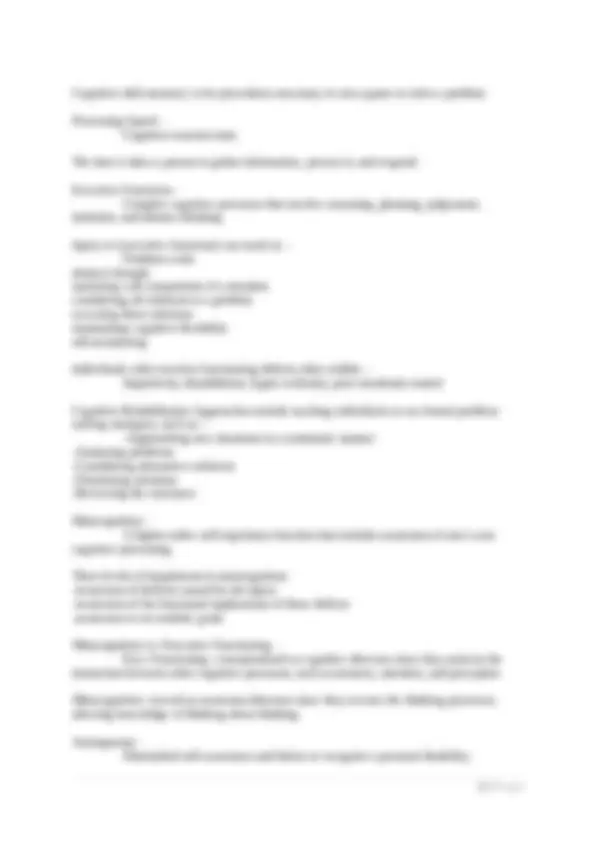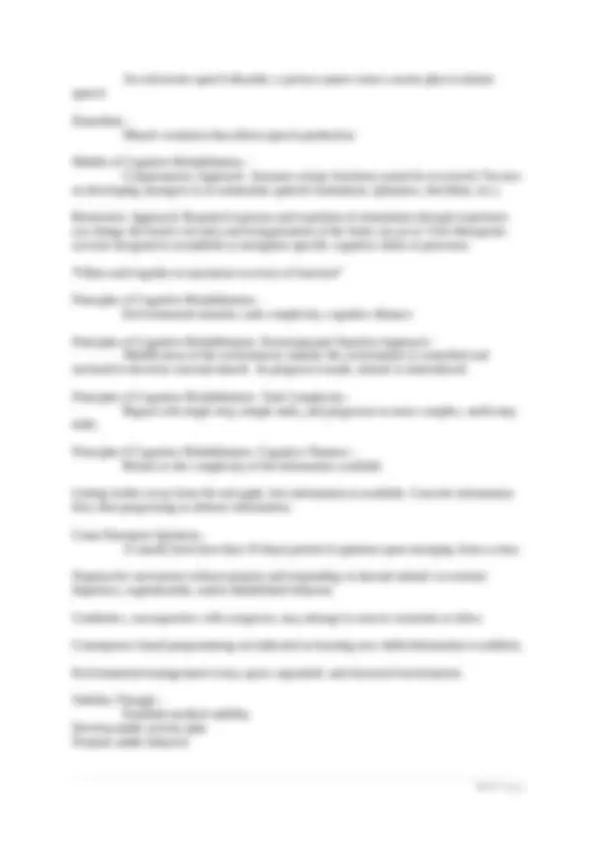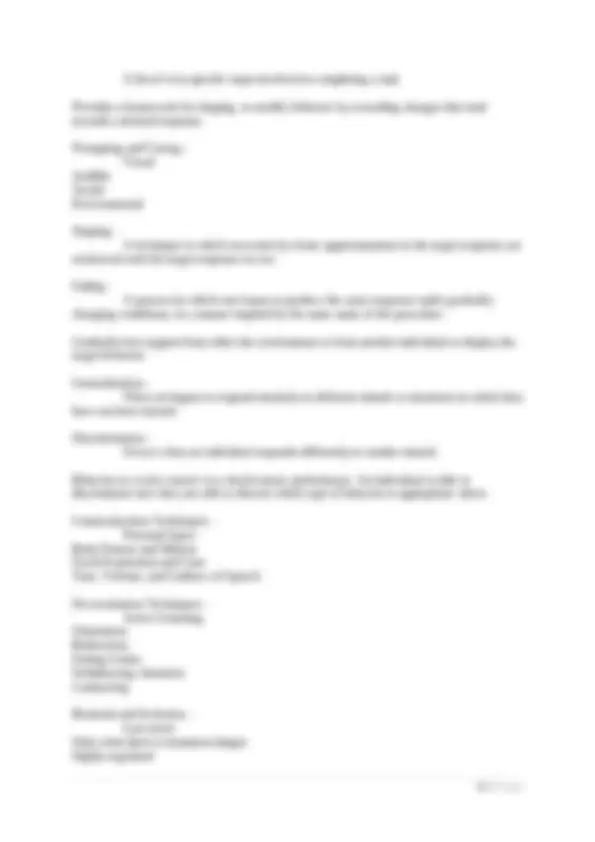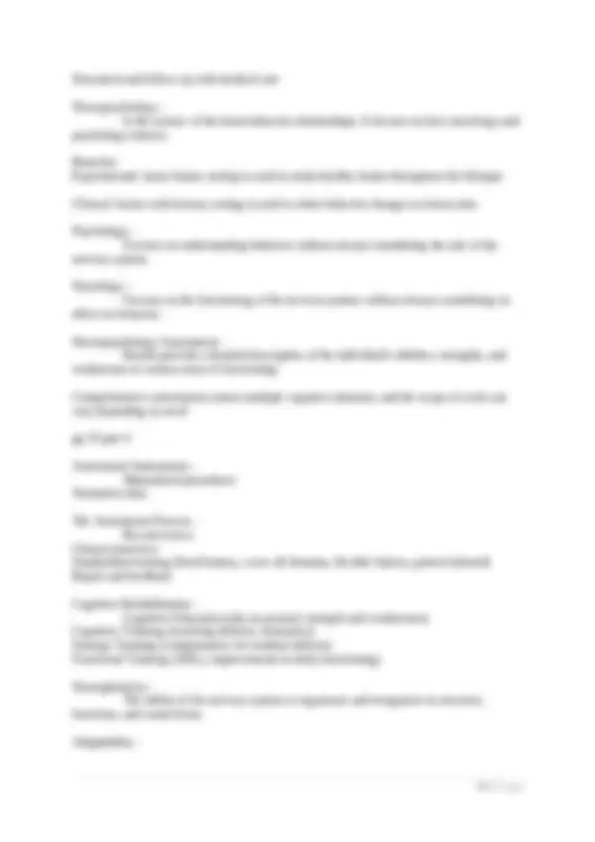








Study with the several resources on Docsity

Earn points by helping other students or get them with a premium plan


Prepare for your exams
Study with the several resources on Docsity

Earn points to download
Earn points by helping other students or get them with a premium plan
Community
Ask the community for help and clear up your study doubts
Discover the best universities in your country according to Docsity users
Free resources
Download our free guides on studying techniques, anxiety management strategies, and thesis advice from Docsity tutors
A detailed overview of neurocognitive issues, focusing on the impact of brain injury on cognitive functions. It explores various cognitive domains, including attention, memory, processing speed, and executive functions, and delves into the mechanisms of cognitive impairment. The document also discusses different approaches to cognitive rehabilitation, emphasizing the importance of environmental stimulus, task complexity, and cognitive distance. It concludes with an introduction to applied behavior analysis and its application in managing neurocognitive challenges.
Typology: Exams
1 / 10

This page cannot be seen from the preview
Don't miss anything!







How many Americans experience disabilities due to brain injury? - 5 million Cognitive impairments include difficulties with: - attention, memory, problem solving, decision making Cognition - A complex collection of conscious mental activities, such as attention, perception, comprehension, remembering, or using language. It is a process by which sensory input is transformed, reduced, elaborated, recovered, and used. Domains of Cognitive Functioning - Metacognition, attention, executive function, processing speed, memory, categorization Metacognition - Self-awareness and knowledge of one's strengths and weaknesses. Subtypes of Attention - Focused, sustained, selective, alternating, divided. Focused Attention - Selecting one source of information while withholding responses to irrelevant stimuli (responding to pain; turning to see what made a loud sound behind you). Sustained Attention - Maintaining attention to complete a task accurately and efficiently over a period of time (reading a book; waiting a TV show; listening to a presentation). Selective Attention - Maintaining attention in the presence of distractions (focusing on a speaker while ignoring talking around you or outside; studying while music is playing). Alternating Attention - Shifting between tasks that demand different behavioral or cognitive skills (reading a recipe and stirring a pot; filing and answering a phone). Divided Attention - Requires the ability to respond simultaneously to multiple task demands while maintaining speed and accuracy (driving and talking on the phone; cooking multiple courses). Attention Process Training Program (APT) - A process-specific approach to cognitive rehabilitation.
Hierarchically organized by difficulty. Begins with sustained attention tasks and progresses to selective, alternating, and divided attention tasks. Categorization - Deficits can interfere with: -The initiation and performance of ADLs. -The acquisition, processing, and learning of new information. -Successful problem solving and decision-making. BI patients tend to categorize based on a single attribute vs more complex/multidimensional stimuli. Memory Impairments - Encoding (where perceived info is put in a context that can be stored); Storage (stabilization of a memory); Retrieval (the search for a memory or activation of a memory). Memory Process - Senses, Sensory memory, Short term memory, Working memory, Long term memory Sensory Memory - Holds information from the senses for a few seconds immediately after the item is perceived; there are five sensory memory senses. Short Term Memory - Enables recall of information that lasts a few minutes to hours. passive Working Memory - Is a central cognitive process responsible for the temporary storage and active processing of information active Long Term Memory - Permanent consolidation and storage of information. Long Term Memory: Explicit Memory - Memory with conscious recall. Semantic memory: words, ideas, concepts; includes general knowledge or facts about the world Episodic memory: personal experiences; includes personal, autobiographical recollections of experiences Long Term Memory: Implicit Memory - Memory without conscious recall. Procedural memory: skills and tasks; allows people to remember how to tie their shoes or ride a bike without consciously thinking about it (muscle memory)
Cognitive Function: Frontal Lobe - Emotional control Behavioral control Verbal expression Problem solving Decision making Social control Motivation Attention Cognitive Function: Temporal Lobe - Memory Face recognition Selective attention Locating objects Object categorization Receptive language Emotional responses Language comprehension Cognitive Function: Occipital Lobe - Visual stimuli processing Cognitive Function: Parietal Lobe - Tactile performance Spatial orientation Academic skills Object naming Visual attention Eye-hand coordination Factors that interfere with cognitive function following a brain injury? - Hearing loss Vision loss Expressive aphasia Receptive aphasia Apraxia Dysarthria Medical stability can compromise cognition Impairments of emotional and behavioral control (damage from the injury, difficulty adjusting, pre-existing conditions) Expressive aphasia - Inability to communicate language Receptive aphasia - Inability to understand language Apraxia -
An oral motor speech disorder; a person cannot create a motor plan to initiate speech Dysarthria - Muscle weakness that affects speech production Models of Cognitive Rehabilitation - Compensatory Approach: Assumes certain functions cannot be recovered. Focuses on developing strategies to accommodate patient's limitations. (planners, checklists, etc.) Restorative Approach: Repeated exposure and repetition of stimulation through experience can change the brain's circuitry and reorganization of the brain can occur. Uses therapeutic exercise designed to reestablish or strengthen specific cognitive skills or processes. Often used together to maximize recovery of function Principles of Cognitive Rehabilitation - Environmental stimulus, task complexity, cognitive distance Principles of Cognitive Rehabilitation: Environmental Stimulus Approach - Modification of the environment; initially the environment is controlled and enclosed to decrease external stimuli. As progress is made, stimuli is reintroduced. Principles of Cognitive Rehabilitation: Task Complexity - Begins with single step, simple tasks, and progresses to more complex, multi-step tasks. Principles if Cognitive Rehabilitation: Cognitive Distance - Relates to the complexity of the information available. Getting further away from the red apple; less information is available. Concrete information first, then progressing to abstract information. Coma Emergent Agitation - A usually brief (less than 10 days) period of agitation upon emerging from a coma. Hyperactive movement without purpose and responding to internal stimuli vs external. Impulsive, unpredictable, and/or disinhibited behavior. Combative, uncooperative with caregivers, may attempt to remove restraints or tubes. Consequence based programming not indicated as learning new skills/information is unlikely. Environmental management is key; quiet, organized, and structured environment. Stability Triangle - Establish medical stability Develop stable activity plan Promote stable behavior
Refers to any process that DECREASES the likelihood that a particular response will occur again. Negative punishment: removal of a stimulus Positive punishment: addition of a stimulus BOTH DECREASE the likelihood that a response will occur again. Examples pg 26 of part 4 Consequence Based Intervention: Reinforcement - Refers to any process that INCREASES the likelihood that a particular response will occur again in the future. Negative reinforcement: removal of a stimulus Positive reinforcement: addition of a stimulus BOTH INCREASE the likelihood that a response will occur again. Examples pg 26 of part 4 Schedules of Reinforcement: Extinction - When a previously reinforced response no longer produces a consequence, leading to an eventual decline in rate. Extinction burst is an initial increase in rate, intensity, and/or change in topography. Schedules of Reinforcement: Intermittent - A particular response sometimes produces a reinforcer. Produces greater variability in topography of the behavior. Utilized to promote generalization and maintenance of behavior. Highly RESISTANT to extinction. ex: slot machines Schedules of Reinforcement: Continuous - A particular response always produces a reinforcer (1:1) Produces less variability in the topography (what it looks like physically) of the behavior. Utilized to promote acquisition of behavior. Highly SENSITIVE to extinction. ex: being paid for each piece of work one completes Task Analysis -
A list of very specific steps involved in completing a task Provides a framework for shaping: to modify behavior by rewarding changes that tend towards a desired response. Prompting and Cueing - Visual Audible Tactile Environmental Shaping - A technique in which successively closer approximations to the target response are reinforced until the target response occurs. Fading - A process by which one learns to produce the same response under gradually changing conditions, in a manner implied by the same name of the procedure. Gradually less support from either the environment or from another individual to display the target behavior. Generalization - When on begins to respond similarly to different stimuli or situations in which they have not been trained. Discrimination - Occurs when an individual responds differently to similar stimuli. Behavior at a rock concert vs a church music performance. An individual is able to discriminate once they are able to discern which type of behavior is appropriate where. Communication Techniques - Personal Space Body Posture and Motion Facial Expression and Gaze Tone, Volume, and Cadence of Speech De-escalsation Techniques - Active Listening Orientation Redirection Setting Limits Withdrawing Attention Contracting Restraint and Seclusion - Last resort Only when there is imminent danger Highly regulated
An individual's capacity to change behaviors in order to adapt to changes in their internal or external environment. Cognitive Rehabilitation: Restorative - Aims to res-establish lost functions or develop new functions. Cognitive Rehabilitation: Compensatory - Designed to minimize the effect of deficits and to recover a degree of function.